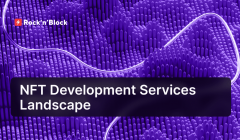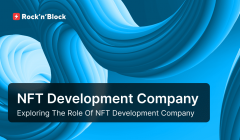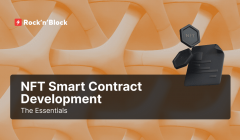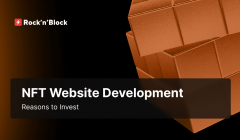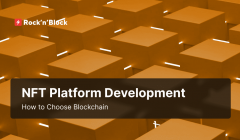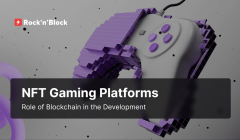Cross-Platform NFT Marketplace App Development
03 May 2024In the rapidly evolving landscape of digital assets, cross-platform NFT marketplace app development is a critical frontier, offering users the flexibility to engage seamlessly across devices. This article serves as a comprehensive guide, shedding light on effective strategies and cutting-edge solutions to overcome the challenges inherent in cross-platform development. From optimizing user experiences to ensuring data consistency and security, the solutions presented here aim to empower businesses and developers in crafting robust, accessible, and user-friendly cross-platform NFT marketplace applications.

Table of Contents:
-
Necessity of Cross-Platform NFT Marketplace App Development
-
Pros and Cons of Cross-Platform Development
-
Designing User-Centric Experiences Across Devices
-
Data Synchronization and Consistency
-
Balancing Functionality Between Mobile and Desktop Versions
-
Conclusion
Necessity of Cross-Platform NFT Marketplace App Development
The NFT marketplace ecosystem is remarkably diverse, encompassing users on various devices and operating systems. From desktop computers running Windows, MacOS, Linux to mobile devices on Android, iOS, and other platforms, the audience engaging with NFTs is vast and varied. With mobile usage comprising 57.87%, desktops at 40.2%, and tablets at 1.94%, and the diverse OS landscape, exemplified by 57.93% iOS and 41.64% Android usage in 2023, underscores the critical importance of cross-platform NFT app marketplace development (the statistics are generalized across users of different platforms and not specific to the NFT community).
Embracing cross-platform development ensures market inclusivity by catering to the preferences of all major devices and OS users, significantly widening the potential user base and enhancing the marketplace's reach and adoption. Cross-platform NFT app development helps ensure consistent user experiences, mitigating challenges associated with different design guidelines and interaction patterns across various operating systems. It also future-proofs the NFT marketplace, ensuring sustained relevance and adaptability in a constantly changing technological landscape.
Devices with different OS range from powerful desktop computers to widely available mobile devices facilitating on-the-go engagement and tablets offering a blend of mobility and screen resolution. Cross-platform NFT marketplace app development becomes indispensable to cater to this extensive spectrum and ensure widespread adoption, emphasizing the importance of a unified user experience across diverse devices and operating systems.
Cross-platform NFT marketplace app development involves creating a digital platform for trading non-fungible tokens (NFTs) that works seamlessly across multiple devices and operating systems. To achieve this, NFT marketplace developers use technologies that enable the NFT app to function uniformly on various platforms, including mobile devices, desktop computers, and web browsers.
The goal is to ensure that all users have a consistent and engaging experience, regardless of the device they use. This enables greater accessibility and inclusivity for participants in the NFT ecosystem. Cross-platform development requires strategic planning to align features, optimize user interfaces, and synchronize data across a range of devices. This contributes to the versatility and adaptability of NFT marketplaces in the ever-changing digital landscape.
Excited about building a trending NFT platform? Check out our comprehensive guide on The Top 5 NFT Marketplace Development Types for 2024!
Pros and Cons of Cross-Platform Development
This section discusses the benefits and challenges of cross-platform NFT marketplace app development, exploring the intricacies that developers must navigate to create strong and adaptable applications.
Unveiling the Benefits of Cross-Platform NFT Marketplace App Development
Embarking on cross-platform NFT marketplace app development opens avenues to a myriad of benefits:
-
Broader User Reach: By ensuring compatibility across various devices and operating systems, cross-platform development expands the user base, reaching audiences on mobile, desktop, and web platforms.
-
Consistent Branding: A consistent user experience across platforms reinforces brand identity. Users encounter a unified brand presence, fostering trust and recognition.
-
Enhanced User Experience: Users benefit from a consistent and optimized experience across all devices, resulting in higher satisfaction and engagement levels within the NFT marketplace app.
-
Inclusive Accessibility: Whether exploring collections during a commute, buying NFTs at home, or engaging from any location, users are no longer confined to specific devices. This flexibility aligns perfectly with the dynamic nature of soft marketplaces, offering users the freedom to participate and transact on their terms without waiting for a specific place or time.
-
Competitive Advantage: Offering a cross-platform NFT marketplace positions businesses competitively in the market, demonstrating adaptability and accessibility to a diverse user base.
Challenges of Cross-Platform NFT Marketplace App Development
However, the path to cross-platform excellence is not without challenges:
-
User Interface and Experience Consistency: Achieving a consistent user interface and experience across different platforms can be challenging due to variations in screen sizes, resolutions, and interaction methods.
-
Technical Performance Concerns: Cross-platform development frameworks may face challenges in delivering optimal performance, especially in resource-intensive applications like NFT marketplaces, leading to potential lag or responsiveness issues.
-
Dynamic OS Updates: Cross-platform NFT marketplace app development requires continuous adaptation to evolving operating system features, APIs, and potential disruptions caused by unforeseen changes. These changes include the dynamic nature of operating system updates across platforms.
-
Security Risks: Ensuring robust cybersecurity across various platforms requires meticulous attention, as vulnerabilities on one platform may differ from those on another, posing risks to the integrity of blockchain transactions and digital assets.
-
Platform-Specific Limitations: Each platform may have unique capabilities or limitations, requiring NFT marketplace application developers to navigate and adapt to platform-specific constraints, which can complicate the development process.
-
Fragmentation in Ecosystems: The variety of platforms and devices can lead to fragmentation of the ecosystem, making it difficult for developers to ensure consistent functionality and compatibility across all supported devices and operating systems.
-
Time-to-Market: The challenge of time-to-market in cross-platform NFT marketplace app development stems from the need to design, develop, and test on multiple devices. With each device introducing complexities, the development process becomes more time-consuming.
Learn the tools and frameworks necessary for developers and entrepreneurs to create adaptable and secure NFT platforms in our guide: NFT Marketplace Development Tools and Frameworks Overview!
Designing User-Centric Experiences Across Devices
In the NFT marketplace app development landscape, creating user-friendly experiences is crucial. This section discusses responsive design for different screen sizes and how to customize user interfaces for mobile and desktop platforms in the context of NFT marketplace development.
7 Strategies for Responsive Design Across Different Screen Sizes
In the realm of NFT marketplace apps development, it is important to prioritize a user-centric approach that emphasizes seamless adaptation to diverse devices and screen sizes. Responsive design aims to maintain a consistent user experience irrespective of the device. Whether users access the NFT marketplace app on a smartphone, tablet, or desktop, the interface offers familiarity and ease of navigation.
1. Adaptive Content Presentation
Adapting the presentation of content based on the platform ensures that users receive an optimized viewing experience. This may involve repositioning elements, adjusting font sizes, or modifying content hierarchy for clarity.
2. Fluid Grids and Flexible Images
By implementing a fluid grid design, the layout of the NFT marketplace app can adapt dynamically to different screen sizes. Additionally, flexible images enhance responsiveness by adjusting proportionally to the available screen space.
3. Media Queries for Device Adaptation
Using media queries enables developers to apply styles based on device characteristics, such as screen width, resolution, or orientation, ensuring an optimal visual experience across a range of devices.
4. Touch-Friendly Navigation
Considering touch interfaces on mobile devices, the design should incorporate touch-friendly navigation elements. This includes larger buttons, swipe gestures, and other touch-centric features that enhance usability on smaller screens.
5. Optimized Mobile Layouts
Designing mobile interfaces requires prioritizing essential features, minimizing clutter, and optimizing layouts for smaller screens. This ensures that users on mobile devices can efficiently navigate and engage with the NFT marketplace app.
6. Desktop Screen Space Utilization
Utilizing the larger screen space on desktop platforms enables the inclusion of more features and improved visual presentations. Desktop interfaces can take advantage of multi-column layouts and richer graphics while maintaining a positive user experience.
7. Unified Branding and Theme
While tailoring interfaces to different platforms, maintaining a unified branding and theme is crucial. Consistency in visual elements, color schemes, and branding elements across devices contributes to a cohesive and recognizable NFT marketplace brand.
Discover the Reasons to Invest In NFT Website Development to take your business to new heights of creativity, commerce, and connectivity in the digital world!
Data Synchronization and Consistency
In the NFT marketplace app development landscape, achieving data synchronization and consistency across diverse platforms is imperative. This section explores strategies for ensuring seamless data consistency and the integration of real-time updates and transactions within the context of NFT marketplace app development.
Strategies for Ensuring Data Consistency Across Platforms
The NFT marketplace app development requires coherent and synchronized data management across multiple platforms.
-
Cross-Platform APIs: Utilizing cross-platform APIs enables standardized communication between different platforms. This facilitates seamless data exchange and ensures that updates made on one platform are reflected accurately on others, maintaining consistency.
-
Atomic Transactions: Implementing atomic transactions ensures that database operations occur as a single, indivisible unit. This approach ensures that all changes in a transaction are either applied or not applied at all, thereby preventing any inconsistencies in the data of the NFT marketplace app.
-
Conflict Resolution Mechanisms: In situations where conflicts arise from multiple platforms updating at the same time, robust conflict resolution mechanisms are critical. This involves defining rules to resolve conflicting changes and maintain a coherent dataset.
Real-time Updates and Transactions
The dynamic nature of NFT marketplace app development requires real-time updates and transactions to provide users with a responsive and engaging experience.
-
WebSockets: Using WebSockets enables real-time communication between the server and clients, ensuring that updates are immediately pushed to users across different platforms for a synchronized experience.
-
Event-Driven Architecture: Implementing an event-driven architecture allows the NFT marketplace app to broadcast events triggered by user actions or system changes. Subscribed clients receive these events in real time, enabling instant updates and maintaining a consistent view of the data.
-
Asynchronous Processing: Introducing asynchronous processing mechanisms enables the NFT marketplace app to handle time-consuming tasks, such as transaction confirmation or data updates, in the background. This ensures that users experience minimal delays and enjoy real-time responsiveness.
-
Data Caching: Employing effective caching strategies helps reduce the load on servers and enhances the speed of data retrieval. Caching frequently accessed data locally on user devices contributes to a more responsive experience while ensuring synchronization with the latest updates.
Balancing Functionality Between Mobile and Desktop Versions
In cross-platform NFT marketplace app development, achieving an optimal balance of functionality between mobile and desktop versions requires a comprehensive approach that integrates both user-centric design and technical prowess.
Technical Strategies for Functionality Optimization
-
Native Features Utilization: Leveraging native features on each platform enhances functionality. Mobile versions can integrate device-specific features like GPS for location-based services, while desktop versions can capitalize on system resources for enhanced computational capabilities.
-
API Integration for Seamless Data Exchange: Integrating robust APIs facilitates seamless data exchange between mobile and desktop versions. This ensures that users experience real-time synchronization of data, such as NFT ownership and transaction history, regardless of the platform they are using.
Conclusion
In conclusion, exploring cross-platform NFT marketplace app development solutions not only reveals the intricacies of overcoming challenges, but also underscores the significant benefits for businesses in this dynamic landscape. Seamless integration across devices not only enhances the user experience, but also opens up new avenues for business growth. The extended reach and accessibility offered by cross-platform solutions translates into a broader user base and increased engagement, maximizing the potential for NFT sales and transactions.
In addition, the optimisation of functionalities and the inclusion of advanced NFT marketplace development features contribute to an enhanced user experience, fostering trust and loyalty among subscribers. By strategically deploying these solutions, enterprises position themselves at the forefront of the evolving NFT market, capitalizing on the intersection of innovation and market demand.
We ❤️ Development
Follow us on social media to receive the hottest blockchain development updates
Twitter ⚡️Telegram⚡️LinkedIn⚡️Facebook
